Marking the twentieth anniversary of the September 11, 2001, terrorist attacks on New York City and Washington, D.C., City Journal is re-publishing selected stories from our archives. This story originally appeared in our Summer 2006 issue.
From Lookout Point at Eagle Rock Reservation in West Orange, New Jersey, you see some of the most spectacular views in the New York metropolitan area. No wonder that early settlers used it as a surveying station and that in the Revolutionary War, Washington’s army set up a post there to chart British movements. Today, the point reveals an unobstructed view of New York’s skyline 15 miles away—which is why Essex County officials chose it as the site for a September 11 memorial. Opened barely a year after 9/11, the $1.2 million, privately financed memorial features a bronze sculpture of an American eagle in flight, inscriptions of the names of all those who died on 9/11, and individual tributes to rescue workers. In its first year, the site attracted some 75,000 visitors, and it continues to draw thousands seeking to remember the dead, to contemplate the heroic acts and sacrifices of that day, and to recall the Manhattan skyline back when the Twin Towers graced it.
The impressive Eagle Rock memorial is one of dozens that have gone up in and around the New York metropolitan area since 9/11, even as controversy and fecklessness have paralyzed efforts to create a memorial on the grounds of the former World Trade Center itself. At Ground Zero, the projected cost of the proposed memorial ballooned to a staggering $1 billion, even though no construction ever began. The commission formed to build the memorial, in utter disarray, has fallen far short of fund-raising goals, prompting the recent resignation of its head and the sharp downsizing of its plans. The monument’s proposed design—dubbed by its creators Reflecting Absence—has faced intense criticism for its vacuity, fastidiously rejecting any tribute to the heroism of the day or the rock-solid American values that the terrorists attacked.
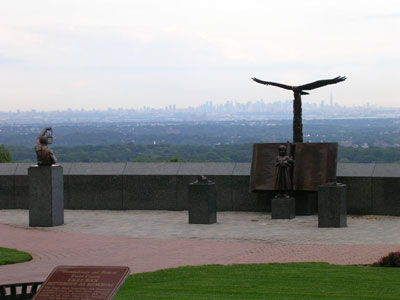
No such paralysis seems to have encumbered the dozens of commissions that local governments and ordinary citizens set up around the tristate area to honor the dead and remember the day. Though the terrorist attacks were a tragedy for the entire nation, they hit home most acutely in the scores of commuter towns within 100 miles of New York City, where many World Trade Center workers lived. Those communities have responded with a wide array of memorials.
Most are modest in scope and cost, but they are often inspired and poignant. Some serve as gravestones for local victims who have no known resting place. Others commemorate the valor that Americans exhibited on 9/11, especially New York’s rescue workers. By contrast, the World Trade Center site will have no unique memorial to the sacrifices of the city’s firefighters and police. In an age when many memorials, like Reflecting Absence, are abstract gestures that avoid invoking anything except loss—and not even directly but in a glass darkly—some of these local monuments are throwbacks, robust statements of American ideals, rendered in an unapologetically realistic style that might dismay postmodern critics but that successfully translates our common feelings about September 11 into concrete form. Deeply moving, a tour of these memorials also reminds us of the gigantic failure that has left Ground Zero little more than an opening in the earth.
One thing that comes through in visiting these memorials is just how much people miss the Twin Towers. The powerful image of the original towers, as a confident emblem of Gotham’s status as a global financial capital, dominates many of the sites. The memorial in Danbury, Connecticut, commemorating the dozens of state residents who died on 9/11, for example, features a 12-foot, 6,000-pound glass tower, with a smaller tower inside. The $130,000 monument, created in just under a year, shimmers in the daylight—a light, airy, peaceful tableau, in marked contrast to our memories of that day. In Manalapan, New Jersey, which lost 11 residents, the heart of the town’s $107,000 memorial is a pair of seven-foot reproductions of the towers in light blue granite, sitting atop an 80-pound section of steel beam from the original towers. Spotswood, New Jersey’s memorial consists of one-ton Vermont granite replicas of the towers, placed at the angle from which Garden State viewers used to see them.

While a celebrity committee has planned the WTC memorial site with distressing results, in some of these other monuments, the work of re-creating the towers has been the labor of love of just a few, or even of a single person. After 9/11, Jared Stevens, a firefighter in Tinton Falls, New Jersey, who had been at the World Trade Center on the morning of the attacks, labored for five weeks in his garage on two eight-foot models of the towers. He lavished attention on the details in the models, including some 40,000 holes drilled to create windows. The models went up in the town just a few days before Christmas 2001, when the pain of the attacks still seared. They’ll remain there “as long as they hold up,” Stevens has said.
No less clear than people’s fondness for the missing towers is the admiration and gratitude they feel for those who worked as rescuers that day, especially the city’s police and firefighters, many of whom headed fearlessly into the burning towers knowing that they might never come out. Many memorials, whatever else they say, take full note of the sacrifices of these rescue workers. The Ground Zero memorial, by contrast, will only scantly acknowledge their heroism, incorporating the insignias of their departments into the work but nothing else.
Perhaps the most robust and stirring tribute to rescue efforts sits in Pennsauken, New Jersey. Town leaders commissioned artist Brian Hanlon, who specializes in traditional sculpture and comes from a long line of firefighters, to create a life-size tribute to the survivors and the rescue workers who helped save them in a monument titled We Shall Never Forget. The $250,000 memorial boasts five life-size figures, including a dazed stockbroker helped by an emergency medical technician, a policeman, a firefighter, and a rescue dog, set against an 8-by-30-foot polished marble wall, inscribed with a 9/11 timeline. At the statue’s foot, one reads the virtues that we honor in the rescuers: bravery, courage, and compassion.
Such realism is perhaps too unrefined for the elite commission members who selected the Ground Zero memorial design. But the vigorous affirmation of the rescuers’ heroism reflects an attitude common among area memorials, if not always as elaborately detailed as in Pennsauken’s massive monument. “A lot of the credit goes to the Pennsauken memorial committee for having the right ideas,” says sculptor Hanlon. “Their work is in contrast to a lot of these elite committees which select memorials based on abstract designs that lack heart and soul.”
September 11 wasn’t just a day of private tragedy; it was also an attack on the United States—a national trauma. A number of memorials fittingly incorporate American iconography into their designs in a way that Reflecting Absence will not. Just as an image of an eagle towers over the Eagle Rock Reservation memorial, Monmouth County, New Jersey’s memorial will also highlight this emblem of America. Artist Franco Minervini, born in Molfetta, Italy, where he watched his grandfather and other stone carvers work, drew inspiration from a twisted beam at the World Trade Center site to create a massive stone monument of an American eagle grasping the beam in its talons. “I wanted to get the symbol of freedom, of America, to take the physical beam and the souls of all those who perished and bring them up to heaven,” Minervini said. The 5,000-pound sculpture, the centerpiece of the county’s nearly $1 million memorial to the 147 county residents who died in the terrorist attacks, sits atop Mount Mitchell Scenic Overlook in Atlantic Highlands, with its panoramic view of the distant New York City skyline.
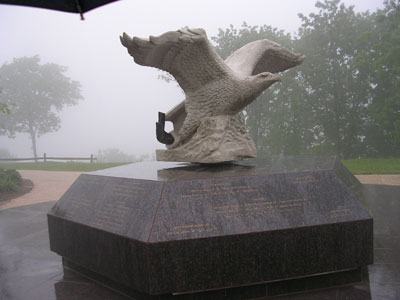
Lack of progress at Ground Zero has frustrated many victims’ families, whose loved ones’ remains have never been found and have no final resting place. In that absence, family members and friends have found consolation in the many memorials that have risen locally. The impetus to complete those memorials has seemed particularly urgent in some of the towns surrounding New York that suffered disproportionately high losses on 9/11.
The town of Babylon, Long Island, lost 48 residents that day and wanted to make a place for the many family members and friends of the dead to mourn. So out of the local beachfront, the town carved a one-acre memorial site that includes headstones for all the victims, adorned with photos and words of remembrance from family members. In Brick, New Jersey, the town installed a statue by Brian Hanlon, Angel in Anguish, to remember its nine local victims. The beachfront statue shows an angel weeping over a tableau of the New York City skyline with the Twin Towers still standing and an American flag flying over them. “The sculpture reflects the anguish I feel, but the angel is also a powerful figure, and you feel, looking at it, that after she’s done mourning she’s going to get up and do what has to be done to carry on,” says Jennifer Sands, whose husband died in the Twin Towers. “None of us here in Brick has any remains or gravesites. This is our gravesite.”
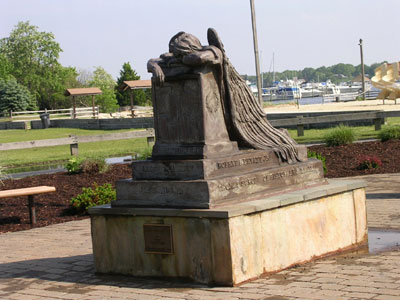
Residents of Middletown, New Jersey, didn’t fully comprehend just how many of their neighbors worked in New York City until the evening of September 11, when police counted 192 cars left in the train-station parking lot. Though commuters stranded in the city would eventually pick up most of the abandoned vehicles, 37 residents of the town died in the attack—leaving a huge sense of loss and longing in the community.
To help fill the void, the town constructed a memorial garden with headstones for all the victims, where family members and friends frequently stop by to leave mementos and messages. On the day I visited the memorial in mid-May, a Mother’s Day card sat propped up on the headstone of Lorraine Antiqua, a 32-year-old single parent who worked for Cantor Fitzgerald and left behind two young daughters. A few steps further on, someone had left two baseballs in small trophy cases before the headstone of Stephen Cangialosi, a Cantor Fitzgerald bond trader and ardent Yankee fan. Nearby, on the headstone of Jane Beatty, a cancer survivor who worked at Marsh & McLennan, family members inscribed, “You were gone before we knew it/And only God knows why.”
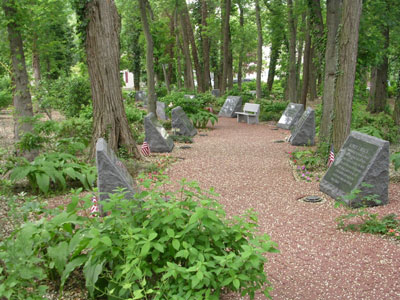
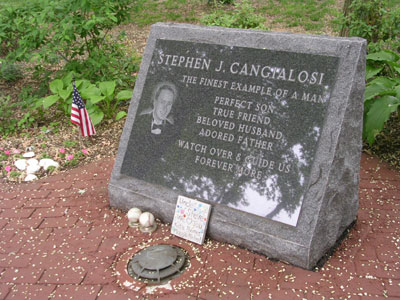
But it’s perhaps the memorial to the victim with no life story to recount and no place on official lists of the dead that is the most touching of all. John and Sylvia Resta of Bayside, Queens, a husband and wife who worked on the 92nd floor of Tower One at Carr Securities, died together that day. Sylvia was seven months pregnant. On the memorial to 9/11 victims in Hazlet, New Jersey, where John’s family lived, is a tribute to the couple. Below their photos is a painting of a small angel, resting its head on a cloud, titled “Baby Resta.” On the day I visited Hazlet, nearly five years after 9/11, someone had just left a small bouquet at the base of the memorial, under the angel, a touching tribute to the victim for whom we have no photograph and no memories, only a dream in a mourner’s mind of what might have been.
Top Photo by Jose Jimenez/Primera Hora/Getty Images


